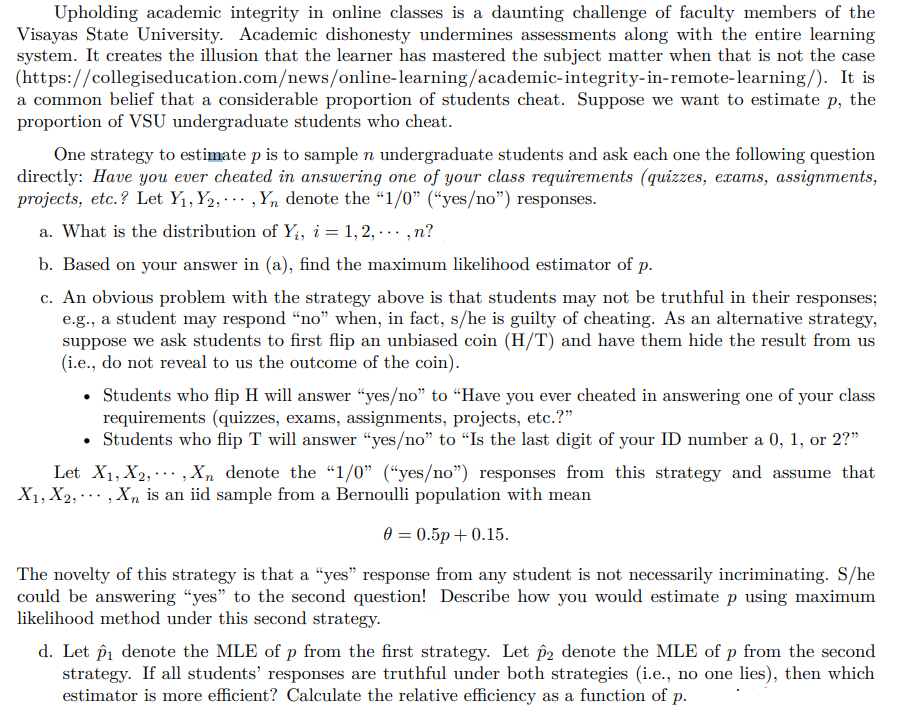Upholding academic integrity in online classes is a daunting challenge of faculty members of the Visayas State University. Academic dishonesty undermines assessments along with the entire learning system. It creates the illusion that the learner has mastered the subject matter when that is not the case (https://collegiseducation.com/news/online-learning/academic-integrity-in-remote-learning/). It is a common belief that a considerable proportion of students cheat. Suppose we want to estimate p, the proportion of VSU undergraduate students who cheat. One strategy to estimate p is to sample n undergraduate students and ask each one the following question directly: Have you ever cheated in answering one of your class requirements (quizzes, exams, assignments, projects, etc.? Let Y₁, Y₂,, Yn denote the "1/0" ("yes/no") responses. a. What is the distribution of Y₁, i=1,2,...,n? b. Based on your answer in (a), find the maximum likelihood estimator of p.
Upholding academic integrity in online classes is a daunting challenge of faculty members of the Visayas State University. Academic dishonesty undermines assessments along with the entire learning system. It creates the illusion that the learner has mastered the subject matter when that is not the case (https://collegiseducation.com/news/online-learning/academic-integrity-in-remote-learning/). It is a common belief that a considerable proportion of students cheat. Suppose we want to estimate p, the proportion of VSU undergraduate students who cheat. One strategy to estimate p is to sample n undergraduate students and ask each one the following question directly: Have you ever cheated in answering one of your class requirements (quizzes, exams, assignments, projects, etc.? Let Y₁, Y₂,, Yn denote the "1/0" ("yes/no") responses. a. What is the distribution of Y₁, i=1,2,...,n? b. Based on your answer in (a), find the maximum likelihood estimator of p.
MATLAB: An Introduction with Applications
6th Edition
ISBN:9781119256830
Author:Amos Gilat
Publisher:Amos Gilat
Chapter1: Starting With Matlab
Section: Chapter Questions
Problem 1P
Related questions
Question

Transcribed Image Text:Upholding academic integrity in online classes is a daunting challenge of faculty members of the
Visayas State University. Academic dishonesty undermines assessments along with the entire learning
system. It creates the illusion that the learner has mastered the subject matter when that is not the case
(https://collegiseducation.com/news/online-learning/academic-integrity-in-remote-learning/). It is
a common belief that a considerable proportion of students cheat. Suppose we want to estimate p, the
proportion of VSU undergraduate students who cheat.
One strategy to estimate p is to sample n undergraduate students and ask each one the following question
directly: Have you ever cheated in answering one of your class requirements (quizzes, exams, assignments,
projects, etc.? Let Y₁, Y₂,..., Yn denote the "1/0" ("yes/no") responses.
a. What is the distribution of Y₁, i = 1,2,...,n?
b. Based on your answer in (a), find the maximum likelihood estimator of p.
c. An obvious problem with the strategy above is that students may not be truthful in their responses;
e.g., a student may respond "no" when, in fact, s/he is guilty of cheating. As an alternative strategy,
suppose we ask students to first flip an unbiased coin (H/T) and have them hide the result from us
(i.e., do not reveal to us the outcome of the coin).
• Students who flip H will answer "yes/no" to "Have you ever cheated in answering one of your class
requirements (quizzes, exams, assignments, projects, etc.?"
• Students who flip T will answer "yes/no" to "Is the last digit of your ID number a 0, 1, or 2?"
Let X₁, X2,,Xn denote the "1/0" ("yes/no") responses from this strategy and assume that
X₁, X2,... Xn is an iid sample from a Bernoulli population with mean
7
0 = 0.5p+ 0.15.
The novelty of this strategy is that a "yes" response from any student is not necessarily incriminating. S/he
could be answering "yes" to the second question! Describe how you would estimate p using maximum
likelihood method under this second strategy.
d. Let p₁ denote the MLE of p from the first strategy. Let p2 denote the MLE of p from the second
strategy. If all students' responses are truthful under both strategies (i.e., no one lies), then which
estimator is more efficient? Calculate the relative efficiency as a function of p.
Expert Solution
This question has been solved!
Explore an expertly crafted, step-by-step solution for a thorough understanding of key concepts.
Step by step
Solved in 4 steps

Recommended textbooks for you

MATLAB: An Introduction with Applications
Statistics
ISBN:
9781119256830
Author:
Amos Gilat
Publisher:
John Wiley & Sons Inc

Probability and Statistics for Engineering and th…
Statistics
ISBN:
9781305251809
Author:
Jay L. Devore
Publisher:
Cengage Learning

Statistics for The Behavioral Sciences (MindTap C…
Statistics
ISBN:
9781305504912
Author:
Frederick J Gravetter, Larry B. Wallnau
Publisher:
Cengage Learning

MATLAB: An Introduction with Applications
Statistics
ISBN:
9781119256830
Author:
Amos Gilat
Publisher:
John Wiley & Sons Inc

Probability and Statistics for Engineering and th…
Statistics
ISBN:
9781305251809
Author:
Jay L. Devore
Publisher:
Cengage Learning

Statistics for The Behavioral Sciences (MindTap C…
Statistics
ISBN:
9781305504912
Author:
Frederick J Gravetter, Larry B. Wallnau
Publisher:
Cengage Learning

Elementary Statistics: Picturing the World (7th E…
Statistics
ISBN:
9780134683416
Author:
Ron Larson, Betsy Farber
Publisher:
PEARSON

The Basic Practice of Statistics
Statistics
ISBN:
9781319042578
Author:
David S. Moore, William I. Notz, Michael A. Fligner
Publisher:
W. H. Freeman

Introduction to the Practice of Statistics
Statistics
ISBN:
9781319013387
Author:
David S. Moore, George P. McCabe, Bruce A. Craig
Publisher:
W. H. Freeman